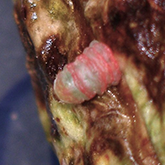Post-doctoral researcher Jeremy Yoder investigates an unusual case of speciation through coevolution in the Mojave Desert.

Like a landscape straight from the imagination of Dr. Seuss, the Mojave Desert is best characterized by its bizarre and spiky Joshua trees. But as you drive across the desert, you'll notice two opposite members of the yucca family. Western Joshua are tall and tree-like, while their eastern brothers are squat and bushy. What's going on with those family genes? Jeremy Yoder, a post-doctoral researcher in the Department of Plant Biology, recently published a paper in the American Society of Naturalists that looks at how species interactions can promote diversification of species—some more effectively than others. Along with international collaborators, Yoder found that it is most often predator-prey interactions or competition for food and habitat that give rise to new species. The Joshua tree case is thought to be a unique instance of coevolution leading towards speciation. Millennia of coevolution have sculpted the Joshua flowers and the ovipositors of the yucca moth into a perfectly matched lock and key. The tiny moth eats only Joshua seeds and pollinates only Joshua flowers while laying its eggs. The tree, in turn, has evolved flower phenotypes that cater to its moth's organs. It’s a prime example of mutualism—the concept that two species depend exclusively on each other. In this case, though, there's a special twist enabling speciation. Yoder investigated how two sets of locks and keys led to the emergence of the two forms of the trees. The tall Joshua is pollinated by a larger species of moth whose ovipositor fits the tree's slender, tapered flowers. The bushy Joshua tree, with its stubbier flowers, is visited by a smaller moth with a shorter ovipositor. It’s just a matter of time to see if the trees’ genetic relationship finally plays out in family estrangement or never-ending sibling rivalry. Yoder studies how sources of natural selection like disease, climate, and species interactions impact species on the genetic level."Life itself generates more life, and more diversity of life," says Yoder, who is expanding his investigations into the evolution of biodiversity. — Lisa Elliott |
|

